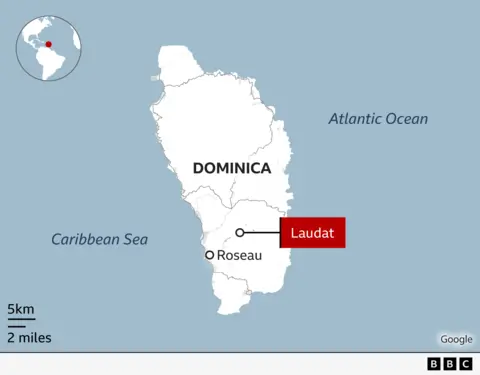“Finding the resource is the first challenge. Then you need someone like us to build the facility,” says Ormat’s chief executive Doron Blachar. “Ormat is doing the entire project, from making the plant’s elements, shipping them to Dominica, mainly from Israel, and then constructing the power plant.”
Ormat has been designing and building renewable energy systems for more than five decades, and owns and operates geothermal plants in various countries from the Americas to Africa.
“Geothermal is a great, zero-emission electricity that doesn’t depend on wind or sun, and operates 24/7,” Mr Blachar explains. “It brings jobs to a country, both during construction and, more importantly, during the plant’s operations, along with new technology and expertise.”

Yet despite geothermal’s green credentials, Dominica’s new plant has raised concerns among some local residents, including environmentalist Atherton Martin who fears for the effects on the ecologically valuable Roseau Valley.
“There is no other area like it in the Caribbean,” he says, adding that the removal of vegetation during the exploration process “decimated wildlife” including endemic frogs.
Other residents told the BBC of some controversy over the amount of money the project was costing. It has certainly been several years in the making with the Dominican government alone said to have invested around $15m (£11.3m).
Dr Henderson admits that the project is “not easy” for a country that “faced a big challenge” when it had to substantially repair its electricity network after 2017’s Hurricane Maria. But he insists “it will be worth it in the end”.
Another common fear about geothermal plants is the potential for triggering earthquakes.
Ormat says it has never had a such an incident in its many years of operations.
 Gemma Handy
Gemma HandyMr Blachar believes the Caribbean could become “a hub” for geothermal technology.
Ormat acquired Guadeloupe’s plant from the French government in 2017 and is currently expanding it to boost its capacity to 25 megawatts.
With support from the CDB and driven by the Organisation of Eastern Caribbean States (OECS) Commission, work is also under way to explore and develop geothermal potential in fellow volcanic island nations Grenada, St Lucia, St Kitts and Nevis, and St Vincent and the Grenadines.
Ormat will operate the Dominica plant for 20 years before handing it over to state electricity provider Domlec. Mr Blachar estimates it will employ around 30 local people when it comes on stream later this year.
It should initially generate enough power to meet half of Dominica’s peak electricity demand, says Fred John, managing director of the government-owned Dominica Geothermal Development Company, which is also involved in the scheme.
Authorities are confident the plant will then soon support the entire country, and have enough spare electricity for some to be exported to neighbouring islands.
Mr John says that the facility will “serve as a test case for an attractive alternative” to fossil fuels. “The rest of the OECS will benefit from the lessons learned here – both what worked and what didn’t,” he adds.
The OECS recently set a target to reach 30% renewable energy within 10 years, with some countries, including Dominica and St Kitts, aiming for 100% by then.
OECS Director General Dr Didacus Jules describes Dominica’s geothermal project as a “bold and visionary step”.
“As a region heavily dependent on imported fossil fuels, the transition to green energy is not optional – it is existential,” he tells the BBC.
“This development also breathes new life into the long-held vision of a regional energy grid – one that connects our islands through clean, reliable, and affordable energy.”